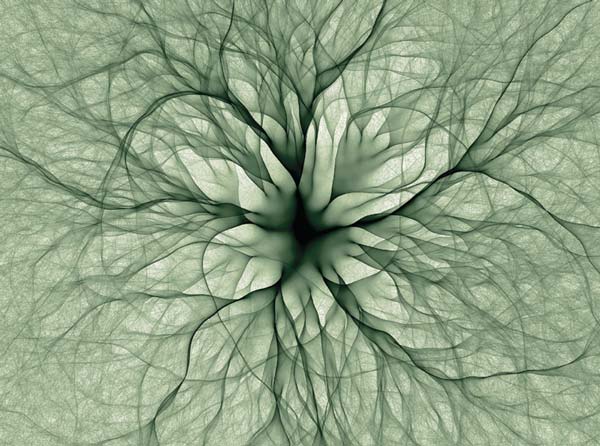Electron Landscape
By Felice Frankel
Harvard physicist Eric Heller maps electrons as they course through a vista the size of a bacterium
Harvard physicist Eric Heller maps electrons as they course through a vista the size of a bacterium

DOI: 10.1511/2004.45.72
Eric J. Heller is professor of physics and chemistry at Harvard University. When we met a few years ago, I was first drawn to Eric's incredible landscape photographs. (I professionally photographed the designed landscape for many years.) He had the remarkable ability to "see" and capture various metaphors of science within the natural landscape. Now he is producing other types of images specifically related to his work and has been exhibiting them around the country.

F. F. Can you first tell us what we are seeing?
E. H. "Transport II" shows the flow pattern for electrons riding over a bumpy landscape. The electrons are trapped in a sheet at the interface between two solids. Such sheets of electrons are of great importance in cutting-edge electronics, forming the basis for sophisticated transistors. The electrons were launched in all directions evenly, one at a time. What you see are their accumulated tracks. The area seen here would correspond in size to a bacterium. The bumpy landscape that the electrons must negotiate is caused by the irregular arrangement of positively charged "donor" atoms in a layer lying just above the flat interface in which the electrons are traveling. The electrons are attracted to regions with more positive charges nearby, and since these charges are randomly arranged the electrons feel hills and valleys of repulsion and attraction. The electrons have more than enough energy to ride over the highest hills, but they are slightly deflected this way and that as they pass by.
F. F. You obviously think visually in your work. Has this always been the case?
E. H. I have always taken a very visual and intuitive approach to my research, which involves the application of quantum mechanics to various problems in the atomic world. I produce images as a regular part of my research, as do many scientists these days. The visual processing power we carry around with us is enormous, and the right image can go a long way to prove a key point or leave a lasting impression on a colleague.
F. F. Do you believe your approach gives you a perspective that leads to new ideas?
E. H. Absolutely. For example, in this image, the concentrations of electron flow into branches are newly discovered indirect effects of that bumpy ride. The branching was not anticipated; it was thought that the flow would be more evenly spread out some distance from the center. This has significant implications for small electronic devices of the future.
F. F. How did you produce the image?
E. H. The image comes from a numerical simulation that closely approximates what is seen experimentally, using extremely sensitive probes that can sample thousands of data points inside a space as small as a typical bacterium. I wrote the computer algorithms that produced the image pixel by pixel. About 15 different algorithms are represented in the exhibits; the algorithm for this one was written in Fortran, an older computer language favored by many scientists.
F. F. Your work has appeared in many exhibitions. We both know what hard work it takes to create an exhibit. Tell us, what do you get from all the effort?
E. H. Imagery is a formidable tool for teaching our colleagues, ourselves and, just as important, the public. For me, the best reward has been to see nonscientists take delight in the images, and then ask about the science behind them. This makes it all worthwhile.
Click "American Scientist" to access home page
American Scientist Comments and Discussion
To discuss our articles or comment on them, please share them and tag American Scientist on social media platforms. Here are links to our profiles on Twitter, Facebook, and LinkedIn.
If we re-share your post, we will moderate comments/discussion following our comments policy.